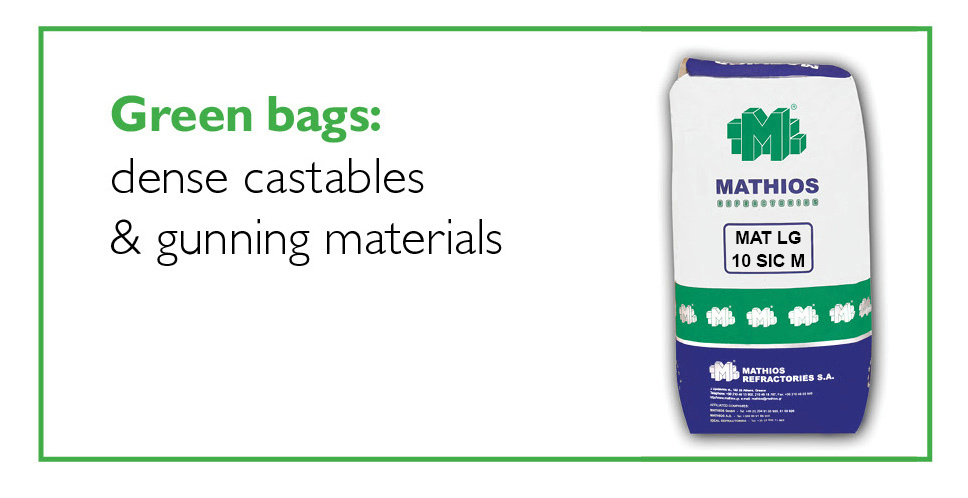[print_link]


![]()
Thank you for choosing our products.
The following instructions will help you make the most out of our quality.
MAT LG 10 SIC M
- Short Description: Monolithic, hydraulic-bonded, Low Cement Gunning (LCG) material, with CaO content 1.5% and 10% Silicon Carbide.
- These refractory materials are packed in special paper sacks, of about 25 kg, on wooden pallets.
- Shrink foil wrapping protects the refractory materials against moisture.
- These refractory materials should be stored in a dry cool warehouse (shelf life is indicated on the Technical Data Sheet). If the shelf life has been exceeded, our Technical Service Department should be contacted before use
- Pallet stacking is admissible and the max loaded pallets must not exceed 3 pallets.
- “First in – First out” management of stored materials is advisable.
- The material has to be stored above freezing temperature.
- Due to high humidity and strong solar radiation in tropical countries, storage in a dry, covered place is recommended.
- The shrink wrapping should be removed only prior to mixing.
- Tools and Machinery/ Preparation before gunning
- Tools, gunning machine and surrounds must be clean and free from foreign material.
- The mould has to be stable to withstand stresses caused by vibration and the weight of the material. The mould must be water tight. Always apply release oil to prevent the mould from adhering to the refractory material.
- The area for gunning must be clean.
- The shuttering of the moulds (wood forms) as well as the back up materials should be waterproofed in order to minimize the water absorption from the gunned refractories. The shuttering can be removed after 24 hours by which time the exothermic reaction of alumina containing castables has taken place. The temperature increase should be checked with a recorder.
- Water required (l/100 kg): Mixing at nozzle
- Material Required at kg/m3 : 2400
- Installation-Gunning
- The gunning machine and the accessories must be clean and free from any foreign materials
- The refractory materials are fed to the hopper of the gunning machine.
- The compressed air pressure and the added water must be carefully adjusted.
- The mixing of the gunned material with the potable water takes place at the gunning nozzle, which is equipped with a water control valve.
- Good communication between the nozzle man and the men operating the gunning machine is required at all times to ensure the installation is correct.
- The control of the added water is critical for the stickiness, the rebound and the generated dust.
- If the gunning mix sticks to the wall with the smallest rebound, the amount of water used is correct.
- If the gunning mix is too wet, it will slide down the wall. The rebound contains set cement and can not be reused anymore.
- The processing quality depends on striking angle, gunning pressure, gunning mix thickness etc.
- The surface of the cast section should be covered with layer sacking material which is to be kept moist during the curing time.
- Anchoring and Supporting
- Depending on the dimensions and the location of the refractory lining it is necessary to use anchors; for temperatures up to 1200°C steel anchors can be used, and over 1200°C ceramic anchors must be used.
- Refractory grade anchors can be selected depending on the highest temperature, the corrosion environment and the specific project conditions.
- Steel anchors can be selected depending on the highest temperature. They must be painted with bitumen or insulated with tape to avoid cracking.
- Steel anchors have to be protected with 30 mm of refractory material against the hot face.
- Drying and Heating up
- Cement based gunning materials must be dried before starting pre-heat.
- All castables have to be compatible with the pre-heat schedule for the whole kiln.
- The drying and pre-heat temperature is available on request from our Technical Service Department.
- Winter precautions
- The L.C.G shall be installed from 10oC up to 30oC.
- If the temperature at the point of installation is below 10 °C, pre-heating is strongly recommended.
- Temperature during setting should be above 10°C.
- In case of, out of temperature limit conditions, please contact our Technical Service Department.
Important Note: The above instructions are suitable for the most of uses. The final User must follow carefully the instructions of Designer of each specific project.
[print_link]
